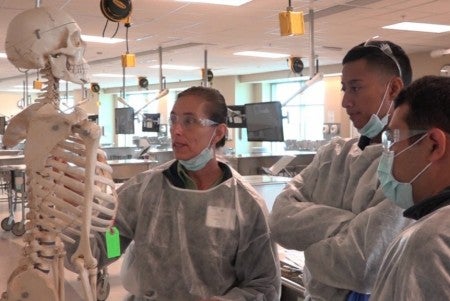About 40 Casselberry firefighter-paramedics attended medical school this week to get an inside look at human anatomy – training they said prepares them to do an even better job at saving lives in emergencies.
The paramedics from Casselberry’s two fire stations spent four days in the UCF College of Medicine’s state-of-the-art Anatomy Lab and learned from faculty and fourth-year medical students who had aced the Anatomy module. “This gives us a sense of human anatomy from the inside, which is something we don’t see,” said Meredith Walker, the Fire Department’s Quality Assurance Officer who is a paramedic and helped organize the training.
The first responders have a range of experience, from nine months to 26 years, and had been trained with mannequins, models, books and movies. The medical school’s lessons came thanks to people who had willed their bodies to science, a gift that was discussed with reverence before class began. Then, clad in protective gowns, boots and gloves, the first responders saw how pacemakers are attached to diseased hearts. They felt the lungs of patients who had suffered from cancer and emphysema. They saw how calcium builds up in the arteries. And they practiced getting blood samples from bone – a process used with injured children whose veins are too tiny to pierce.
“This was a great opportunity to get hands-on practice,” said firefighter-paramedic Diane Meadows, who is also a registered nurse. “We deal with emergency situations in the field, and have very limited opportunities to get extra training with real cadavers. In my 20 years, this is the first real exposure that has been so beneficial.”
Paramedics brought to the lab the tools they use in the field so they could see how treatment impacts internal organs. They witnessed how intubation actually fills the lungs with air and how pumping air too quickly – which can happen in a high adrenaline emergency – causes the lungs to inflate too much.
Walker initiated the learning partnership, reaching out to UCF after learning about its lab and willed body program on medical school web site. Working together, the Fire Department and the College of Medicine arranged the cadavers, set up the learning stations and the curriculum. “We approached the college, and they were very open to the idea,” said Casselberry Fire Department Battalion Chief Theresa Krebs. “We’ve felt that eagerness to do the partnership from our first meeting on.”
Casselberry’s Fire Department responds to about 4,500 calls a year in the small Seminole County community. Of those, 70 percent of those are emergency medical calls. The first responders said seeing human anatomy and impact of disease from the inside will help them provide better care to patients during an emergency. And the learning experience was also an eye-opener for medical educators and students. They learned about real-life trauma injuries and the challenges to make lifesaving decisions quickly with only the tools at hand.
“This experience has made me a better teacher,” said Dr. Andrew Payer, professor of anatomy at the College of Medicine who runs the Anatomy Lab. “In this partnership, we both benefit. The paramedics have more confidence in their knowledge of human anatomy. They have a deeper understanding of how their actions impact the body. These first responders are helping people in trouble. And who knows? Maybe someday, one of them may be helping one of my family members.”
To view a video version of this story, please visit
